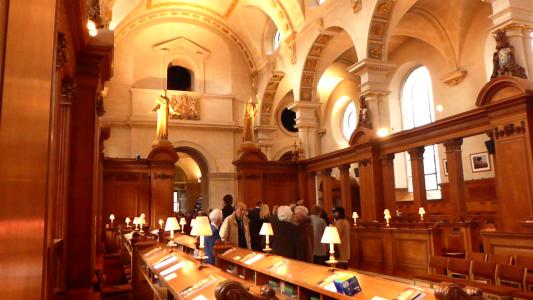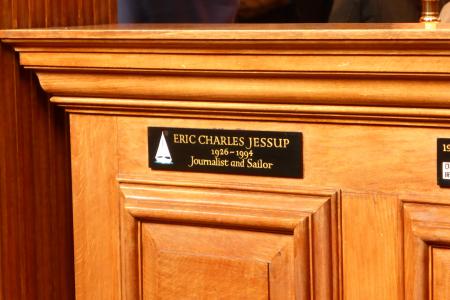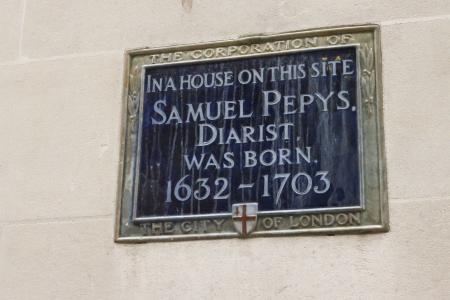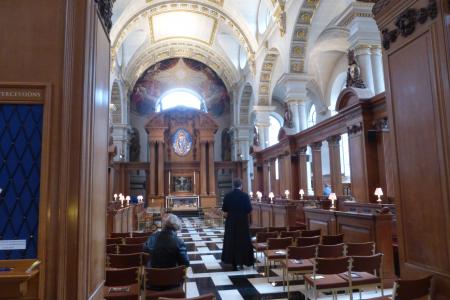PDC World Championship 2016 - 1
The Journalist's Church
 This year my World Championship started with a Christmas Carol Service in the journalist's and media church. I planned to visit the church but it was by chance I visited the service.
This year my World Championship started with a Christmas Carol Service in the journalist's and media church. I planned to visit the church but it was by chance I visited the service.
Its logical there exists a journalist's church in London- even the media needs a spiritual centre. And as the church is already some hundred years old it is almost logical as well, that it was Christopher Wren who build it, as Wren was the one who rebuild 51 churches after the big London fire in 1666. St. Bride's in Fleet Street is one of these, not really the best known and to be sure often overlooked by tourists as it is hiding in a narrow backstreet.
At the time of the big London fire there already existed for some centuries a St. Bride's church at the same place. How old the church really was, was only found out by excavations in the 1950s after the church had been destroyed once more this time by the German Blitz during World War II. One had already know there was a crypt which was used as a burial ground but only the excavations showed there had been a place of worship at the Roman times . It was much later though she became the journalist's church. For the Roman's and many centuries after them it was a place with a holy well which played it's part in the coronation festivities of the English queens and kings till it dried up around 1830.
 St. Bride (known as St Brigid as well) was an Irish nun who lived between 453 and 525 and was well-known every where in Europe for her piety and friendliness. Already in her lifetime she was worshipped as a saint. It might be herself founded the first stone church built in the 6. Century on the Roman ruins.
St. Bride (known as St Brigid as well) was an Irish nun who lived between 453 and 525 and was well-known every where in Europe for her piety and friendliness. Already in her lifetime she was worshipped as a saint. It might be herself founded the first stone church built in the 6. Century on the Roman ruins.
In the following centuries the church often was reconstructed and enlarged. By it's location between Westminster - the city of the royals and the government - and the city of London - the commercial city - it had many advantages. Around the church a lot of clergy settle for which it was just too expensive in the City and with the clergy script and with it came script and book art. 1501 one of William Caxton's printing prentices moved to the St. Bride's churchyard with his printing press with movable types. Other printers followed as did authors and diarists of those days - thus the printing centre of London around Fleet Street was born and the church became it's spiritual centre. In the year before the big fire the plague came to London and a lot of parishioners were under the around 100 000 plague death's of London as they didn't have the money to leave the town. Than in 1666 the Great Fire of London destructed the town and other than St.Paul's St.Bride was completely destructed.
 But it was one of the first churches to be rebuilt and could be reopened again in 1675. It took a little bit longer to rebuilt the steeple.. Till today the steeple qualifies as the model for the first multi-levelled marriage cake which a baker in Fleet Street baked for his own marriage. 1702 the very first regularly daily newspaper was printed in Fleet Street. It didn't stay the only one and all were produced in Fleet Street and its side lanes. The printing industries attracted intellectuals, actors and artists. Everybody who was anybody could be seen in the cafes of the area.
But it was one of the first churches to be rebuilt and could be reopened again in 1675. It took a little bit longer to rebuilt the steeple.. Till today the steeple qualifies as the model for the first multi-levelled marriage cake which a baker in Fleet Street baked for his own marriage. 1702 the very first regularly daily newspaper was printed in Fleet Street. It didn't stay the only one and all were produced in Fleet Street and its side lanes. The printing industries attracted intellectuals, actors and artists. Everybody who was anybody could be seen in the cafes of the area.
In World War Second St Bride and the streets around it were destroyed by German bombs. It took till 1954 till one started to rebuild it - according to the original plans of Christopher Wren. In the year's before one had excavated and found the Roman ruins and many, many human skeletons. 1957 the church was finished and took up it's service as church of the press and the journalists again. In the 1970's the computer started to replace the old printing methods and many of the newspapers moved away from Fleet Street. But St. Bride's stays till today the church of the journalists and of media even when now-a-days in the parish a lot of other professions can be found.
